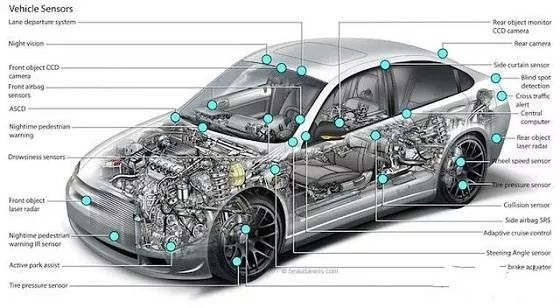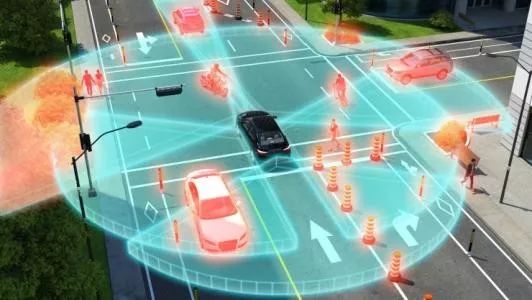The birth of the car has brought convenience to people's lives. In recent years, with the continuous expansion and deepening of the application field of artificial intelligence technology, automatic driving has gradually entered the public's field of vision, and it has become a relaxed matter for consumers to drive.

In the development of autonomous driving technology, the choice of laser radar or camera as the main sensor is the primary problem, they represent two completely different systems - Laser SLAM (Simultaneous Localization And Mapping) and visual SLAM.
camera
Phil Magney, founder and head of VSI Labs, said that perception is a major area of ​​the autonomous vehicle software stack, and there are many innovations in it, and the camera is an essential sensor.

On the evening of March 13, 2017, Intel announced the acquisition of Mobileye for $15.3 billion. Why did Intel achieve the biggest transaction in the auto industry last year at a premium of one-third?
In 1999, two researchers from the Hebrew University of Israel founded Mobileye, a company dedicated to the vision system of cameras and software algorithms for solving vehicle driving problems.
It is precisely because vision is the only indispensable sensor technology in autonomous vehicles, and based on Mobileye's leading position in autonomous driving car vision, Intel has hardly contributed to this marriage. Intel said it is combining Mobileye's "computer vision, sensing, convergence, map construction and drive strategy" with Intel's "open computing platform."
It is understood that the in-vehicle camera is the basis for implementing many kinds of early warning and recognition type ADAS (Advanced Driver Assistance System) functions. Among many ADAS functions, the visual image system is more basic, and the driver is more intuitive, and the camera is visual image processing. The basis of the system.
Many functions such as lane departure warning, forward collision warning, traffic sign recognition, pedestrian collision warning, driver fatigue warning, etc. can be realized by means of the camera, and even some functions can only be realized by the camera.
In addition, the camera not only captures images at high resolution, but also better classifies objects. What are their disadvantages? "The data depth of the camera is not as good as the lidar," Magney said.
Lidar
With the fiery heat of driving, the laser radar has been sought after as never before. Lidar (Light Detection And Ranging) is a combination of laser, GPS and inertial measurement devices. It is able to distinguish pedestrian and character posters in real movement, model in three-dimensional space, detect static objects, and accurately measure distance.

Its working principle is also well understood. The radar system that detects the target position and velocity by emitting a laser beam has the advantages of high measurement accuracy and direction.
In the ADAS system, the laser radar obtains characteristic data such as the position and moving speed of the target object based on the TOF time-of-flight principle through the lens, laser transmitting and receiving device and transmits it to the data processor; at the same time, the speed, acceleration, direction, etc. of the car The feature data will also be transferred to the data processor via the CAN bus.
Subsequently, the data processor comprehensively processes the information data of the target object and the vehicle itself and issues a corresponding passive warning command or active control command according to the processing result, thereby implementing the assisted driving function.
The mainstream laser radar on the market or in autonomous driving projects now accounts for about 90% of the applications of autonomous driving. Laser-radars are basically used in driverless cars developed by companies such as Google, Audi, Ford and Baidu.
In addition, according to the number of wire harnesses, laser radar can be divided into single-line laser radar and multi-line laser radar.
Single-beam lasers are mainly used to avoid obstacles. They are accurate in testing the distance and accuracy of obstacles around them. However, single-wire beams can only be scanned in a plane, and the height of objects cannot be measured. Multi-line laser radar has become a deficiency for single-line laser radar. , there is a qualitative change in dimension elevation and scene restoration, which can identify the height information of the object.
It is understood that the current internationally launched four-wire, 8-wire, 16-wire, 32-wire and 64-wire, multi-line laser radar is mainly used in radar imaging of automobiles.
summary
Drivers used for control are either cameras or laser radars. This is a consensus that has been reached in the industry, but which one is used is still in dispute. Some views hold that there is not such a contradiction between the two. The two technologies have their own advantages and disadvantages. Complementing each other is a relatively achievable route at this stage.
From a deeper perspective, the choice of sensors is actually a matter of automatic driving route selection. If autonomous driving is to be anthropomorphized, then Lidar is basically not needed. The vehicle relies on its own knowledge base and rule base to complete the dynamic judgment of the surrounding environment and vehicle control.
There are also views that the problem between the two is which side of the real industry development is more focused. In the case of Tesla, it focuses on the camera and the millimeter wave sensor. However, due to the frequent occurrence of Tesla accidents, more and more enterprises are beginning to question the relatively low cost and easy to promote. In addition, the media said that Wisla began testing the model series equipped with lidar in North America.
Autopilot is a systematic project. Sensors are indispensable and can't work independently. Based on the perfect combination of reality, the autopilot can go as fast as possible.
REMOTE CONTROL SOCKET
Important Safeguards
When using any electrical appliance, in order to reduce the risk of fire, electric shock and/or injury to persons, basic safety precautions should always be follow8d. including:
• The appliance is for household and indoor use only.
• Before plugging in. check that the voitage on the rating label is the same as the mains supply.
• To protect against electric shock, do not immerse any part of the product in water or other liquid.
• This socket is intended for use by competent adults only and children should be supervised at all times.
• Do not use the socket for other than its intended use.
• This socket can be used by children aged from 8 years arxl above and persons with reduced physical, sensory or mental capabilities or lack of experience and knowledge if they have been given supervision or instruction concerning use of the appliance in a safe way and understand the hazards involved. Children shall not p<ay with the appliance Cleaning and user maintenance shall M be made by children without supervision.
• Children of less than 3 years should be kept away unless continuously supervised.
Children from 3 years and less than 8 years shall only switch on/off the appliance provided that it has been placed or installed in its intended normal operating position and they have been supervision or instruction concerning use of the appliance in a safe way and understand the hazards involved. Children aged from 3 years and less than 8 years shall not plug in. regulate and clean the appliance or perform user maintenance.
• Don't use this socket in the immediate surroundings of a bath, a shower or a swimming pool.
• In case of malfunction, do not try to repair the socket yourself, it may result in a fire hazard or electric shock
Do Not Exceed Maximum a680W
Place the LR44 batteries provided into the compartment in the back of the Remote Control, please insert as sho*/m in the back of the compartment to ensure the polarity is correct.
Programming Instructions
• Plug the Remoce Socket$($)lnto the wall socket(s) and switch on the mams supply, the red LED will flash every second.
• If the LED is not flashing press & hold the manual ON/OFF button for 5 seconds until it Hashes
•Press any ON switch on the Remote Control for approximately 2 seconds and the Remote Socket(s) learn the code. The LED will stop flashing top confirm the codehas been accepted.
• Any number of Remote Sockets can be programmed to one Remote Control ON button to create multiple switching.
• To programme o<her Remote Sockets on different Remote Control ON buttons repeat the prevous steps
• If the mains supply is turned off the Remote Sockets v/ill lose their code and it wil be necessary to re-pcogramme.
Operation:
• Plug your appliance(s) into the Remote Socket(s)
• Press the programmed ON or OFF button on the Remote Control to control the Remote Socket.
♦ The Remote Sockets can also be operated manually using its ON/OFF Button Trouble shooting
If a Remote Socket does not react to the Remote Control please check the followng:
♦ Low battery in tbo Remote Control
• Distance too large between the remote control and the recerver (ensure the range distance is no more than 20 clear Metres) and free from obstacle that may reduce the distance.
• If programming has not been successful, tum the power off and back on then follow the programming steps above.
How to decode
• Press the manual ONX)FF button for 5 seconds until the red LED flashes once per
second to confirm de-coding is successful
♦ Press the ALL OFF switch on the Remote Control for more than 3 seconds, the LED
flashes once per second to confirm (decoding successful.
Voltage: 240V-/50HZ
Max power rating: 3680W max.
Remote frequency:
Remote range:
Battery Type:
433.92MHz
230 Metres
Button Cell 2x1.5V LR44 =
Please check with your local waste management service authority regarding regulations for the safe disposal of the batteries. The batteries should never be placed G municipal waste.
Use a battery d^posal facility if available
M
For eioctncal products sold within the European Community. At the end of the electrical products useful life, it should not be disposed of wth household waste. Please recycle faaMies exist. Check with your Local Authonty or retailer for recycling advice.
C€
remote switch,remote plug,remote control switch,remote power switch,remote control sockets
NINGBO COWELL ELECTRONICS & TECHNOLOGY CO., LTD , https://www.cowellsocket.com